What’s Happened to My Shrubs? Identifying and Treating Caterpillar Damage

Last week, as I walked out into the back garden, I noticed something that didn’t look right with my a few of my yellow bell shrubs (Tecoma stans stans).
The photo, above, shows how they should normally look, however, last week, they looked like this….
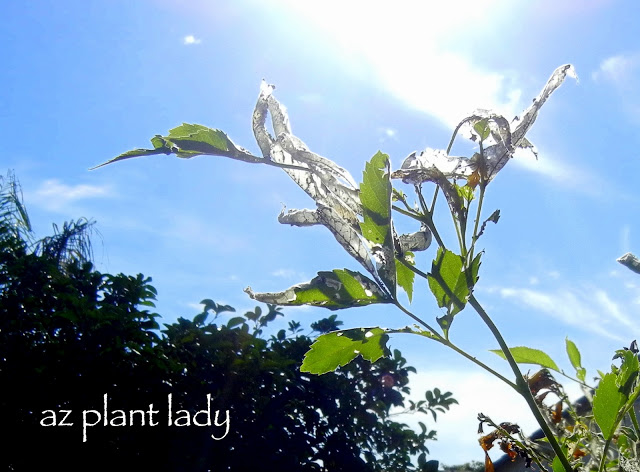
Definitely not normal looking and manyM of the outer leaves were skeletonized, and it got worse. All four of my yellow bell shrubs had the same symptoms. So, did my orange jubilee shrubs, which are closely related.
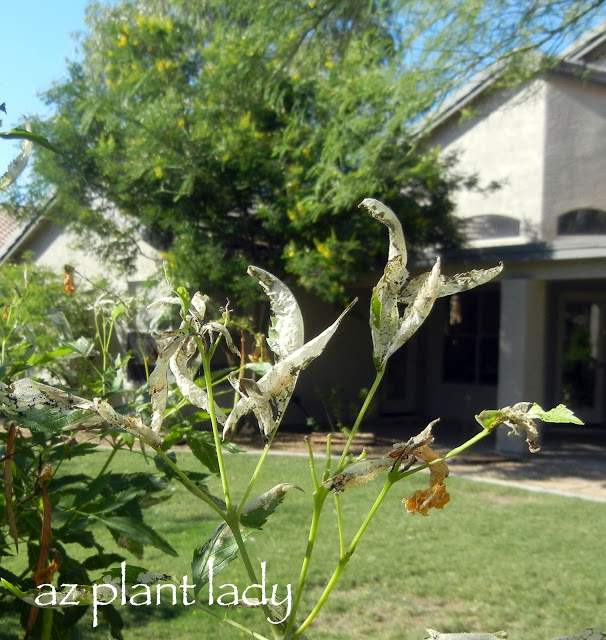
To be honest, I was a bit stunned to see the damage. You see, I had grown these beautiful shrubs for over 14 years and have never seen this before – not even in landscapes I managed or when consulting.
What was interesting is that other shrubs right next to my yellow bells and orange jubilee weren’t in the least bit affected. So, what is eating my leaves?
I looked at the symptoms – the skeletonized leaves, the fact that many of my leaves were ‘rolled’ and little black dots (insect poop) told me that my shrubs were suffering from ‘looper caterpillars’ which are tiny caterpillars that roll the leaf around them while they eat. It is hard to spot the caterpillars themselves, but the damage they cause, usually makes it easy to diagnose.
If your Tecoma or Bougainvillea shrubs show significant leaf damage, here are a few different options on how to treat it:
1. Prune off the affected growth and dispose of the leave in the trash can (not in your compost pile).
2. Treat your shrub using a biological pesticide that contains BT (Bacillus thuringiensis), which is ingested by the caterpillars. BT basically ‘eats’ its way from the caterpillar’s stomach outward. I use a ready-to-use-product.
**Whenever using any pesticide – follow directions carefully. For my shrubs, I will prune back the damaged growth and not apply pesticides. However, if the caterpillars continue to attack, then I may decide to use a product with BT.
So, if you have yellow bells or orange jubilee shrubs – check them to see if they are being affected by caterpillars.
**If your bougainvillea leaves are showing signs of being chewed – they may have been visited by ‘bougainvillea looper caterpillars.’ For more information on how to recognize and treat these caterpillars, click here.
Thankfully, the rest of my garden is looking healthy 🙂
Are Caterpillars Eating Your Shrubs? How to Recognize and Treat Them

 Noelle Johnson, aka, 'AZ Plant Lady' is a author, horticulturist, and landscape consultant who helps people learn how to create, grow, and maintain beautiful desert gardens that thrive in a hot, dry climate. She does this through her consulting services, her online class Desert Gardening 101, and her monthly membership club, Through the Garden Gate. As she likes to tell desert-dwellers, "Gardening in the desert isn't hard, but it is different."
Noelle Johnson, aka, 'AZ Plant Lady' is a author, horticulturist, and landscape consultant who helps people learn how to create, grow, and maintain beautiful desert gardens that thrive in a hot, dry climate. She does this through her consulting services, her online class Desert Gardening 101, and her monthly membership club, Through the Garden Gate. As she likes to tell desert-dwellers, "Gardening in the desert isn't hard, but it is different."

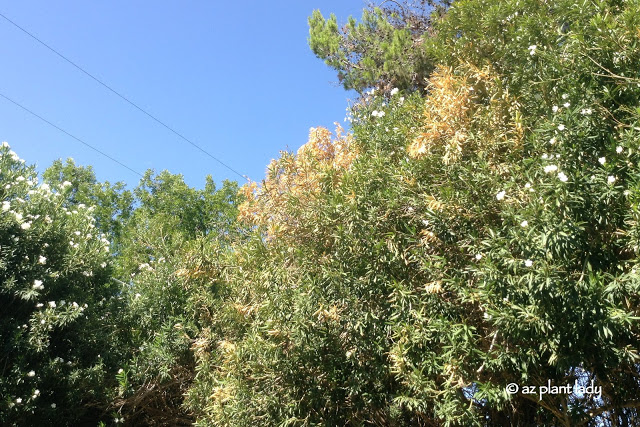

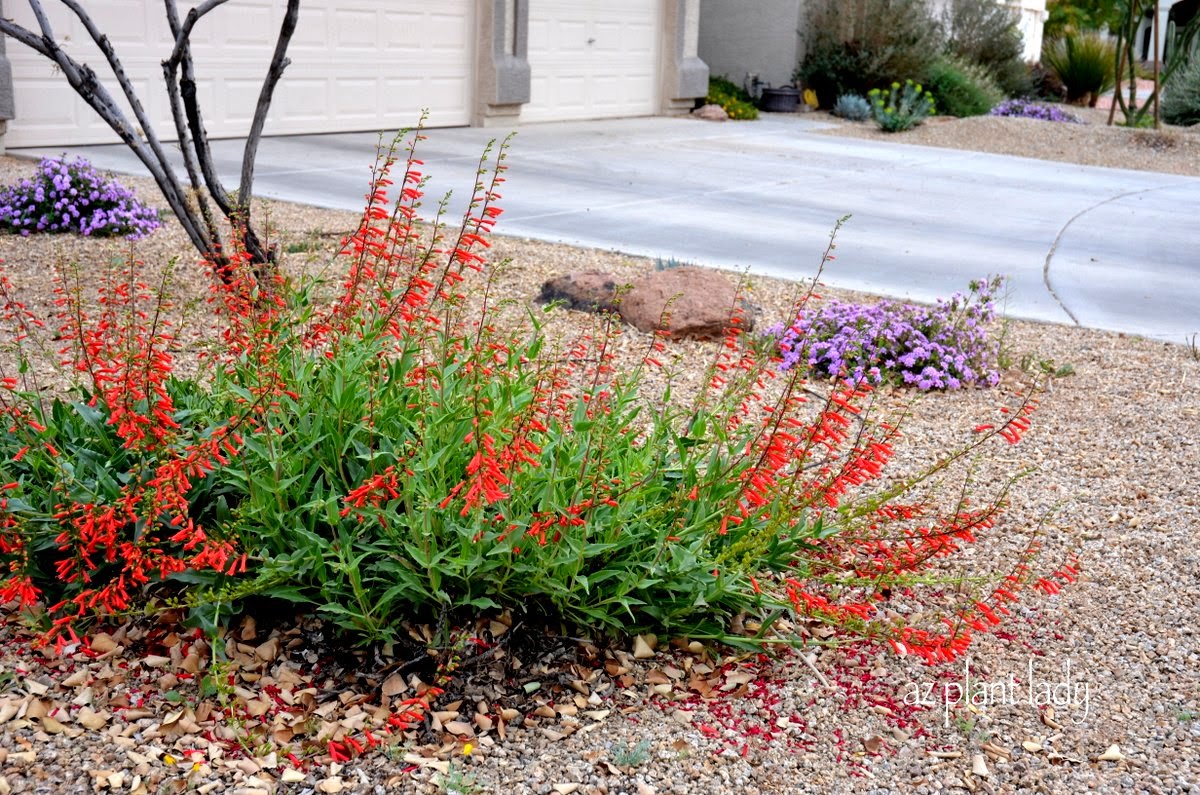







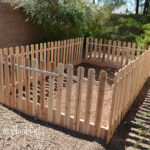

I love Tecoma stans and have many bushes too. Thanks for the tips as I will be on a look out for these threats to them.
I'm in Tucson and I've got the same damage to my cape honeysuckle and bouganvillea. I already cut back the bouganvillea and I guess I'll have to do the honeysuckle as well. I really HATE to use any pesticide, so maybe I'll just see what happens just by cutting them back. Good to know that what I was thinking about the rains this summer was probably right! Thanks for the info!
That happened to my grapefruit tree one year. I cut practically half the tree and it grew back beautifully. I did not want to spray anything on it, since it was consumable. Thankfully I got rid of whatever they were just by cutting them off.
Noelle, we had the same issue here in Tucson. And it was the first year for this problem here as well.
Many of the Tecomas here in Sun Lakes are very affected. Some look totally consumed. Mine have it but not too badly. Also my bougainvillea have been eaten. I have lived in the Valley for 30 years and never seen anything like it. We have had summers with quite a bit of rain before. I just can't figure it out. I didn't use chemicals this year and, like you recommended, just cut off the infected parts. But next year I will take stronger measures if it happens again. I don't want the plants weakened so they die. That's my fear!
Thank you for providing ALL the possible solutions to this pest problem. I have looked at many sites and found only one or two on them. Most do recommend pruning and disposing, however, I am of the opinion that by only doing this we are only spredding the pest to more areas. I would rather kill the bugs then dispose of the damaged parts if necessary. At the moment (2014), BT is the most evviromentally friendly caterpiller killer. Also, one must remember that is you had the pest this summer, they will be dormant is the soil through the winter and emerge next spring/summer. Be prepared to combate them before you get much damage. It appears though that this problem is here to stay because even if you get rid of them in your yard, they will migtate from the other plants in your area. So sad…
Citrus leaf damage is usually caused by a different bug, mine was from the Giant Swallowtail butterfly caterpiller. Look up an image of them, they are so ugly, and worse in real life. The were easy to see so picked them off but BT will work for them as well. I put mine in a covered aquarium with leaves. Hopefully they will turn to butterflies.
I noticed that a few leaves on one of my Tacoma Stans Orange Jubilee plants were shriveled this fall, and I immediately wondered if it was caused by “Thrips”, but after reading your comments, I wonder if it was the same
problem that you had? I did not have the webby covering that were evident on your leaves. Having dealt with Thrips years ago, , I cut off the affected areas and have noticed no further problem. I also gave a little more Miracle Gro soil around the plant base, which seemed to perk it up. I have five of these plants in my Xeric yard, in Sun City. I enjoy your website, and I am in agreement with you about letting shrubs grow naturally. i have several Green Cloud Sage
and Texas Sage, which I do not allow to be made into little balls and triangles. They grow to 6-8-10 feet tall and
as wide, with only a little hand pruning where needed every two years.
Hello,
Thank you for your comment. I would bet that your ‘Orange Jubilee’ shrubs were affected by caterpillars – I’ve never seen thrips bother them. BT will definitely help the caterpillar problem.
I am so glad to hear that you allow your Texas sage to grow into their natural form. Hopefully when you neighbors see how beautiful yours look they will want to grow theirs out 🙂
I have been fighting these pests on my 7 yellow Bell bushes by both cutting the affected areas out AND treating with BT and its has been a huge battle. What month in the fall will they finally leave my plants alone?
Hello Marianne,
I’m sorry to hear that you are having problems with your yellow bells. Sadly, the caterpillars won’t stop eating until winter, and if we have a mild winter, then they will keep on eating, although slow down somewhat. If the damage isn’t too severe, I advise making peace with some eaten leaves. However, if it is severe and doesn’t get better, I would look to plant something else that the caterpillars will leave alone.
So what do these caterpillars turn into, any pictures of the moth/butterfly culprit?
Hello Marie,
They turn into a moth. I’m sorry, but I don’t have a photo of one.
We lost two beautiful full tacomas last year, cut them down to the base. They have returned, again beautiful, but I see some of the interior leaves are showing damage. I hope spraying will deter the hefty damage we had last year.
Thank you for the help with my yellow bells. I am so glad I found this site.
You are very welcome, Laura!
Hello everyone! I live in Chandler, AZ just outside the Phoenix area. I’ve got something weird going on with my several of my Tecomas. I have a yard full various colors to support all my little hummingbirds and assorted bees, etc. The record setting temperatures this year have been horrid, but my plants have been through hot summers before. The other day, I was trimming off some excessive foliage since they tend to lean forward. A couple days later I noticed that one entire branch had totally died. Upon further inspection, I noticed several others that had done the same thing and yet, part of the bush was still alive and is showing no signs of distress. This has occurred twice before with my Tecoma Tree (yes, I have groomed it to be a beautiful small tree), but only affected one small branch each time. I removed the dying branch after it was dry and the rest of the tree continued to flourish. I waited until the branch was dry in an effort not to shock the tree. Likewise, I am doing the same with the affected bush albeit the damage is on a much larger scale. Has anyone else had this problem? I also made sure the ground was not over saturated, but I notice where some of my Tecomas have a drip system, a white fungus developed. I removed the stepping stones and made sure the ground all around the Tecomas was dry before turning on the automatic sprinkler/drip system again. I’d appreciate any feedback you all may have to share.
Hello Janice. I haven’t seen Tecomas with fungus, but it can happen. This is usually due to too frequent watering and not allowing the soil to dry out. Pruning during the summer can be stressful for plants, but I’m not sure that is what causing the dieback. My advice is keeping dead growth pruned out and allowing them to completely dry out before watering again. I hope this helps.
Hello!
I have been fighting this battle with these little caterpillars for the entire summer lol. I do have a problem with the inside of my plants. They are green and lush around the outside but the inner leaves are very brown and shriveled. Any ideas? I wish I could post a picture.
Hi Kylei,
What type of plants are having this problem?